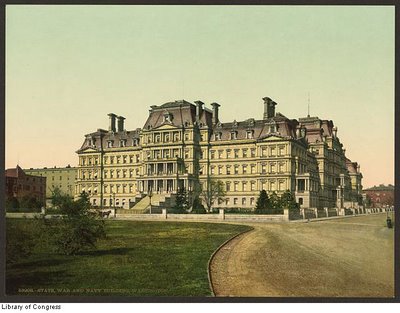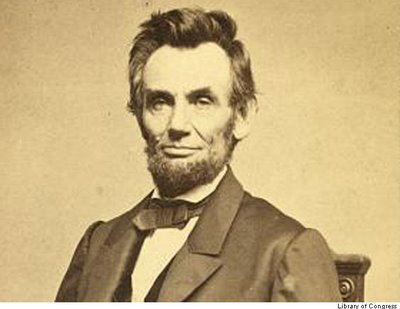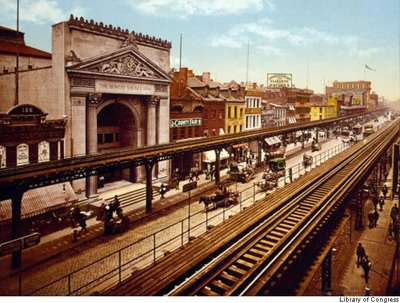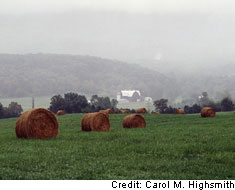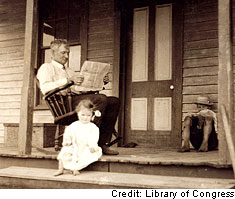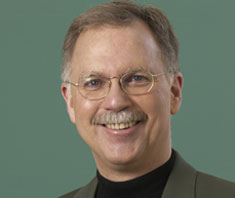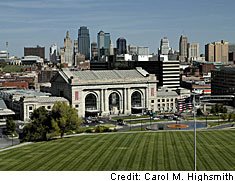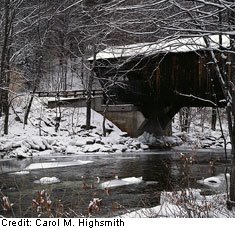A week or so before the change of U.S. administrations, I happened to see a brief television interview with a man – a professed Democrat – in what looked like a feed store in the southern state of Arkansas. He said he had voted for Republican presidential candidate John McCain rather than Democrat Barack Obama. It wasn’t any of Obama’s policy proposals that bothered him, he said. And certainly not the man’s race. Rather, it was because “he’s a city fella. He don’t understand people like me.”
This is an occasional complaint about our new president, and it has been since Obama made one of the few missteps of his campaign. Badly trailing Senator Hillary Clinton in the Democratic primary in Pennsylvania, Obama told some well-heeled contributors at a private function in San Francisco that rural folks back east in that industrial state were “bitter” over lost jobs and “cling to guns or religion or antipathy toward people who aren’t like them.”
There went any chance that Obama would win over Pennsylvania gun owners, and Clinton trounced Obama in that primary. Though he later captured the state in the general election, rural white males like our Arkansan would be his weakest demographic.
 |
| Some say Barack Obama’s “city sophistication” charmed young voters in particular and helped get him elected |
Barack Obama is a city fella, all right, notwithstanding his roots in rural Kansas and youthful time spent in polyglot Hawaii and Indonesia. He is, and says he will always be, a man of Chicago, his adopted hometown, where the pace is a touch faster than in Kansas wheat country or laid-back Hawaii. Or the Arkansas Ozarks, for that matter.
Thus Obama is the latest president in a long line who seem to personify the places from which they came.
Harry Truman, once a Missouri hat salesman, and Gerald Ford, a former star football player at the University of Michigan, were good-natured, plain-speaking Midwesterners of the sort who’d lend you, if not literally the shirts off their backs, at least a chainsaw if you needed one. Nobody called them elitists.
 |
| Talk about smug! Look at the aristocratic pose by Franklin Roosevelt, in the bowler, even before he was president |
Franklin Roosevelt and John F. Kennedy were witty, inspirational patricians, at ease on yachts and in dinner-party circles. George H. W. Bush, too.
Though the elder President Bush was a self-made, West Texas oil millionaire, his Northeast rearing and accent, Yale education, summer home in Maine, and New York years as United Nations ambassador reinforced an aristocratic mien.
 |
| This is the part of the country that has produced three of the past eight presidents |
Bush’s son, George W., and Lyndon Johnson years earlier, were archetypal Texans. Johnson, one of U.S. history’s shrewdest deal-makers while in Congress, was a bear of a man with big ears, a good heart, a tall hat, cowboy boots, and a drawl straight out of the Hill Country. Bush the Younger quickly displayed a line-in-the-sand, duel-at-high-noon, man-of-few-words determination of a Texan who knows his way around horses, oil, long guns, and money. Athletes, too; Bush owned a major-league baseball team for a time. Both those who liked Bush and Johnson and those who loathed them agreed they could be Texas stubborn, too.
 |
| And this area has given us two recent presidents. Neither this nor the dry Texas prairie, above, is exactly “Obama Country” |
Richard Nixon and Ronald Reagan were divergent kinds of Californians. Not mellow surfer dudes or tuned-out hippies or migrant pickers, for sure. But in the mold of many Californians, each was a Midwest transplant who came looking for a new start and better opportunities. Modest of means himself, Nixon rode the wind of arch-conservative, Communist-fearing, “new money” prosperity in booming Southern California. And Reagan, with ever so much more charm and oozing the confidence of the New West, walked onto the big screen, then into our living rooms on TV, and finally into the White House.
None of these men, though – not even the erudite Roosevelt – was that true city fella from down the block like Barack Obama.
 |
| Barack Obama is a big-city guy. THIS big, brawny city: Chicago |
Our 44th president is Chicago, if not in breeding then in style and nimble swagger and survival skills. In particular, South Side Chicago – the poorer side and the part of town where most residents are black.
Much has been written of Barack Obama’s multiracial heritage and the exotic places of his past. But to get a fix on the man, you have to know Chicago. As Ronald Reagan was California and George W. Bush was Texas and you could easily picture Harry Truman back in that haberdashery in Missouri, Obama is Chicago.
 |
| There’s “Chicago big” and “Chicago tall” as well. Sears Tower is 442 meters tall – 527 meters if you count the antennas |
Chicago, not Illinois. Just as New York City is a beehive of bigness in a fairly bucolic state, Chicago is the burly king of the American heartland. Illinois is corn country.
Poet Carl Sandberg called Chicago “The City of Big Shoulders”:
Hog Butcher for the World,
Tool Maker, Stacker of Wheat,
Player with Railroads and the Nation’s Freight Handler;
Stormy, husky, brawling.
 |
| Ray Kroc opened the first McDonald’s here in Des Plaines, a Chicago suburb, in 1955. He made $366 the first day. This is a recent photo, but the old prices are still posted, just for fun |
Still considered by most Americans, including me, to be the nation’s “Second City” even though sprawling Los Angeles has taken its place in size, Chicago is home to America’s tallest building (Sears Tower), the world’s largest private building (the Merchandise Mart, with 36 hectares of floor space), and civilization’s largest free library. Chicago spawned roller skates, the Ferris wheel, zippers, pinball machines, spray paint, the first skyscraper, gangsters like Al Capone, and McDonald’s golden arches. Right in downtown Chicago, you’ll find the only river in the world that was trained to run backward; in 1900, engineers, using a system of locks, turned the flow of the Chicago River around, preferring to ship the city’s sewage west- and southward to St. Louis, rather than into Lake Michigan along Chicago’s “Magnificent Mile” of high buildings, fine shops, and resplendent parks.
 |
| I think I’ve shown this to you before, and it’s no less embarrassing the second time! |
Though more than a century has passed since ten thousand visitors a day came to watch brawny men with sledgehammers deliver the coup de grace to bellowing hogs and steers at the Union Stock Yards, this boisterous, boastful, teeming city of a hundred discrete neighborhoods is still the alpha dog of the Prairie. And it well earns its “Windy City” nickname. Witness (in the photograph to the left) that fellow in red, whose umbrella is fighting a losing battle against gusts off Lake Michigan. That is I in the pitifully inadequate plastic poncho. Chicago’s wind does not just whip or whistle or mournfully howl. It fairly screams off the lake and the plains.
 |
| Polish sculptor Magdalena Abakanowicz created the “Agora” sculpture in Chicago’s Grant Park, along the lakefront. Chicago has the largest Polish population outside Poland |
Yet Chicagoans will tell you that their city is “so livable.” And it is, with 34 world-class museums, America’s best pizza – I’ve tried ‘em all* – 25 kilometers of bathing beaches, almost twice that expanse of bicycle paths, and a veritable outdoor sculptural arcade of bronze rabbits, horses, elephants, surreal human figures, and all manner of other indescribable forms. The Chicagoans I know don’t even notice, any more, Alexander Calder’s 16-meter-tall, steel “flamingo” in the plaza of three downtown federal buildings; Claes Oldenburg’s 30-meter-tall column in the shape of a baseball bat; or Pablo Picasso’s untitled steel creature in the Daley Center plaza.
(*About that pizza: I haven’t really tasted them all. Yet.)
 |
| Buckingham Fountain, and its spray, are beautifully illuminated at night |
While button-popping boastful of its modern art, Chicago also preserves and protects its old treasures. Since 1927, for instance, the city has unofficially marked the beginning and end of summer with both a party and a huge volunteer clean-up of the Clarence Buckingham Fountain in Grant Park. Modeled after a fountain in Versailles, it has three basins carved from pink marble, and four massive pairs of bronze sea horses.
Cynics and those who were suspicious of the company Barack Obama was keeping as a South Side community organizer have long gloated over the years when Chicago led the nation in judges and council members on the take, votes by dead people, numbers of illegal speakeasies, deaths by gangland machine gun, and excessive-force complaints against its police. The “rackets” – the extortion of citizens and small businesses for a percentage of their earnings – were once a Chicago way of life. The end of the federal prohibition on alcohol, crackdowns by local and federal gangbusters, and the imprisonment or violent demise of prominent mobsters broke the Syndicates, though corruption seems to periodically sprout new tendrils.
Chicagoans still worry about random criminal acts, but they more often grumble about the bitter blizzards, interminable construction and high tolls on the ribbons of freeways, and the inadequacies of the local professional sports teams. Most especially the “lovable losers” from the North Side: the Chicago Cubs, who have not won the championship of baseball for 101 years (and counting, say those who mock them). You might think recent ineptitude on the field was to blame. But “Cubbie’” fans ascribe their recent misfortune to the “Curse of the Billy Goat,” dating to 1945, when the owner of the downtown Billy Goat Tavern was asked to remove himself and his goat from a Cubs’ game because the animal smelled bad. Since then, just the ball team has stunk.
(Though President Obama is an avid sports fan, these travails may bore him. He roots for – indeed often wears the insignia cap of – the grittier White Sox, who play, usually more skillfully, on the South Side.)
There’s not much else to complain about in Chicago. There are parks everywhere, many connected by a belt line of boulevards. It’s little wonder that Chicago’s motto is Urbs in Horto: “City in a Garden.” (Urbs : where “urban” comes from.)
 |
| Lots of people from around the world will have an easy time ordering at this Chicago restaurant. I see the German and Polish, but can you identify the third language for me, and maybe translate? |
With the recent heavy in-migration of Koreans, South Asians, and Latinos, Chicago’s tightly bunched European enclaves have been diluted but made more interesting.
Where cities like San Francisco and New York have notable Chinatowns, Chicago has a “Little Seoul” and a Mexican chamber of commerce.
Not to worry: You’ll have no trouble finding a Polish church (or sausage), a German beerhouse, or a Swedish bakery in town.
 |
| These scenes from early Chicago span more than a century, from 1729 to 1857 |
Fittingly in a city of such diversity – and even more appropriate for the place that gave the nation its first African-American chief executive – the “Father of Chicago” was a black man: fur trader Jean Baptiste Pointe DuSable, who in 1799 built a home near the present site of the beautiful Wrigley Building at the mouth of the Chicago River. He established a trading post that served English, French, and Indians alike and brokered peace among neighboring Great Lakes tribes.
 |
| This statue of Louis Armstrong stands far from Chicago,in New Orleans, where the great jazzman made his mark. But he made much of his music, and his living, later in Chicago |
Chicago was the principal destination of the Great Migration of blacks from the South in the early 1900s, when the mechanization of cotton cultivation pushed more than six million African Americans off the farm and toward the industrial North. Chicago would spawn musical legends like Miles Davis and Duke Ellington; welcome King Oliver and Louis Armstrong from New Orleans; and produce another black man – Dr. Daniel Hale Williams – who performed the first successful surgery on the human heart. Barack Obama, a student of American history, knows of them all, and he certainly knows the nation’s most popular television personality, Oprah Winfrey, who’s Chicago-based as well.
 |
| Here’s a page from an old Sears Catalog. You could order thousands and thousands of things from these catalogs – even a new house! |
A rail line from the east and a canal heading westward sparked Chicago’s tumultuous growth in population, manufacturing, and food processing. By 1900 a former traveling salesman, Aaron Montgomery Ward, and a watch merchant, Richard Warren Sears, would separately bring the goods of Chicago to country stores, farmhouses, and city and village homes nationwide through direct sales from the Montgomery Ward and Sears-Roebuck catalogs. Many frontier homes were built of prefabricated materials ordered from those catalogs and shipped from Chicago.
Chicago’s spectacular greensward along the lake, offset by a long row of skyscrapers, grew above one of the most incredible landfill projects in history. Rubble from the terrible Great Chicago Fire of 1871 was tossed wholesale into Lake Michigan, so that Michigan Avenue no longer bordered the lake at all. What resulted was a stunning – and zealously protected – urban playground that, today, annually draws more than 65 million picnickers, bathers, skateboarders, chess players, fireworks watchers, and nocturnal smelt fishermen.
 |
| Here’s a crafty smelt fisherman at work with his net, way back in 1923 |
That’s right: smelt fishermen. (Just the word “smelt” makes me smile.) The Web site I Fish Illinois calls the smallish Atlantic smelt a “naturalized exotic,” transported from the East Coast and let loose in about 1912. The idea was to offset the dwindling supply of lake salmon, and it worked. There are now millions of smelt, which make tasty meals for the salmon, sturgeon, and pike. To this day, from late March to the end of April, spawning smelt are easy pickings for Chicago’s net fishers, cats, and raccoons. Another online site, for the Forest Preserve District of Cook County (greater Chicago), says of smelt, “The flesh is lean and sweet. The gourmet prefers the whole smelt rolled in flour or cracker crumbs and fried in deep fat. He eats head, tail, bones and all.”
Not me, brother. I savor my smelt filleted, or not at all.
How’s that for a meandering, from Barack Obama to Chicago to ichthyology? We return you now to the City of Big Shoulders:
 |
| Chicago has wonderful monuments, parks, and sculptures. But perhaps its favorite landmark is the old Chicago Water Tower, which made it through the terrible Great Chicago Fire |
Following the Great Fire, a Gothic stone water tower on North Michigan Avenue survived to become a symbol of the city’s rebirth.
Chicago even developed a stirring motto: “I Will,” as it erected new libraries, hotels, homes, and statues in a spectacular rebirth.
“I Will,” back then. Obama’s “Yes We Can,” today.
Architects flocked like smelt to the booming new town on the prairie. (OK, enough with the smelt, which don’t “flock,” anyway.)
 |
| Chicago architects made the modern skyscraper possible, and then the city went somewhat wild erecting them. Here’s a recent view from Lake Michigan |
Daniel Burnham – who would soon command the great World’s Columbian Exposition of 1893 – and his partner, John Wellborn Root, devised the idea of “floating” a high-rise building on a steel-and-concrete pier sunk in the city’s spongy soil. At sixteen stories, their 1891 Monadnock Building became the world’s tallest office building and is still the tallest wallbearing structure; walls two meters thick support the enormous weight. William Le Baron Jenney improved the design of such buildings with an internal iron skeleton rather than ponderous external walls. Thus he is regarded as the “father of the skyscraper.” Others, notably Louis Henri Sullivan and Frank Lloyd Wright, developed an entire “Chicago School” of architects, building far more practical structures than the ornately detailed centers of commerce that had been the fashion. “Form,” Sullivan preached, “follows function.”
 |
| You get two ideas from this photograph, taken about 1943: Chicago was a booming rail center. And it gets mighty cold! |
Burnham’s great expo ignited a cultural explosion, including the founding of the Chicago Symphony and the city’s first opera company. Writers like Eugene Field and our Big Shoulders guy, Carl Sandburg, flourished. World War I, Prohibition, and the Great Depression brought disquieting cycles of prosperity, immigration, and crime. So city officials threw another party – another world’s fair – in 1933 that was so popular, they extended it a full year. By World War II, Chicago was a railroad vortex – the Pullman sleeping car was developed there – and the locus of the agricultural Midwest’s “breadbasket to the world.”
It was also the center of the nation’s anarchist movement, bootlegging, and, as I’ve noted, the art of political corruption. Chicagoans took it all in stride, perhaps because every corner in every neighborhood traditionally had one or more taverns on it, serving as the community’s six-day-a-week social center. The church parish hall filled the role on Sundays. Two Mayor Daleys – Richard J. and his son Richard M., the longstanding and current mayor, respectively – considered them eyesores, and their numbers began to diminish. Neighborhood gentrification brought trendy art galleries, boutiques, jewelry shops, tapas bars, and cozy restaurants that make Chicago so – what’s that word again? – livable today.
 |
| Here’s an early shot of the “El” line on Chicago’s “Loop.” At first the train seems like it’s at ground level. But take a closer look |
In Chicago, at least downtown, one is rarely “out of the Loop,” the name for the elevated railroad line that has encircled the commercial center since 1893. In fact, it’s quite impossible to ignore the “El” when trains rattle past your bedroom window. For sure Barack Obama, the son of Chicago, will never be out of the loop, at least for four years.
Chicago’s two daily newspapers and a lively free paper called Reader devote long sections to “Chicagoland’s” vibrant club scene. Nightspots in town carry intriguing names like Elbo Room, Set ’Em Up Joe, Empty Bottle, Hoghead McDunna’s, and the Bourgeois Pig. And those are just the rock bars. Folk, country, blues, gospel, jazz, and even Korean percussion, flamenco guitar, Greek music, and players of instruments called the klezmer and cimbalom have regular followings.
No wonder Barack Obama is “cool.”
And Michelle Obama – a South Side Chicago native – is, too. According to Robin Givhan, the often-caustic fashion editor of the Washington Post, “Chicago has never been about fashion. Until now.” Not a slinky or outlandish runway-model sort of fashion, but a solid, Midwest “conservative chic” made popular by the sunny woman who is now the nation’s first lady. “She smoothly shifts from designer dresses priced at more than $1,000 to mass market brands,” Givhan writes. “She shops at Chicago’s exclusive North Rush Street, and she browses the Internet.” Not since the glamorous Jacqueline Kennedy in the early 1960s has a first lady so captured the fancy of the stylish set.
When Barack Obama dons his White Sox cap, he makes a Chicago statement as well. He is a “man of the people,” certainly of “city fellas” and gals. In his last days in town, he did not visit with his old colleagues at the University of Chicago School of Law, where he taught. He hung with the barbers, short-order cooks, and pickup-game basketball players of his organizing days.
He also vowed to bring the family back to Chicago “every six weeks or so.” The demands of national and world events may put a crimp in that plan. But the Obamas have no villa in Hawaii; no brush-covered, Bush-style ranch; no Kennedyesque compound on a cape. Just their last family home in leafy Hyde Park.
“Chicago will always be home,” Valerie Jarrett, a Chicago lawyer and longstanding friend who is now senior adviser to the new president in Washington, said of Obama. “The White House will be a home away from home.”
Think about that: Perhaps the most famous residence on earth will be nice, flattering, and comfortable, but a second home to their house in Chicago for Michelle, Malia, and Sasha Obama.
And Michelle’s husband, Barack, that city fella.
If you were wondering about the “Obamanin’ Town” reference in the headline to this post,” it’s a riff on Fred Fisher’s 1922 song “Chicago, Chicago, That Toddlin’ Town,” later famously sung by Frank Sinatra. Although Sinatra is most often associated with the gambling resorts of Las Vegas, where he was a superstar headliner, he must have liked the Illinois city by the lake, since just about every night he also sang, “My kind of town, Chicago is.”
(These are a few of the words from this posting that you may not know. Each time, I’ll tell you a little about them and also place them into a cumulative archive of “Ted’s Wild Words” in the right-hand column of the home page. Just click on it there, and if there’s another word in today’s blog that you’d like me to explain, just ask!)
Bootlegging. Making or selling illegal whiskey. The name is said to derive from an early practice of hiding a contraband bottle in one’s boots. They must have been bigger boots than we wear today.
Ichthyology. The study of fishes. Ichthys is Greek for “fish.”
Ilk. Of a kind or sort. A person of a certain ilk shares the qualities – or foibles – of others of that same ilk. Picky pedants cite a more arcane meaning having to do with baronial estate names, but the informal if imprecise definition above is in vogue today.
Mien. One’s bearing – how you carry yourself. Thus we sometimes read about a person’s low mien (not a Chinese delicacy) or regal mien.
Speakeasy. This was an establishment, carefully guarded by a suspicious doorman, that served alcoholic drinks during the Prohibition period from 1923 to 1933, when such sales were banned. But the term goes back at least 30 years or more before that. Pirate hideouts carried the name, and a Pittsburgh, Pennsylvania, woman who sold liquor without a license is said to have advised her customers to “speak easy” if they wanted to buy some.
Well-heeled. Wealthy. People of means, of course, can afford fine footwear. Fine fighting cocks were also said to be well-heeled with deadly spurs.






